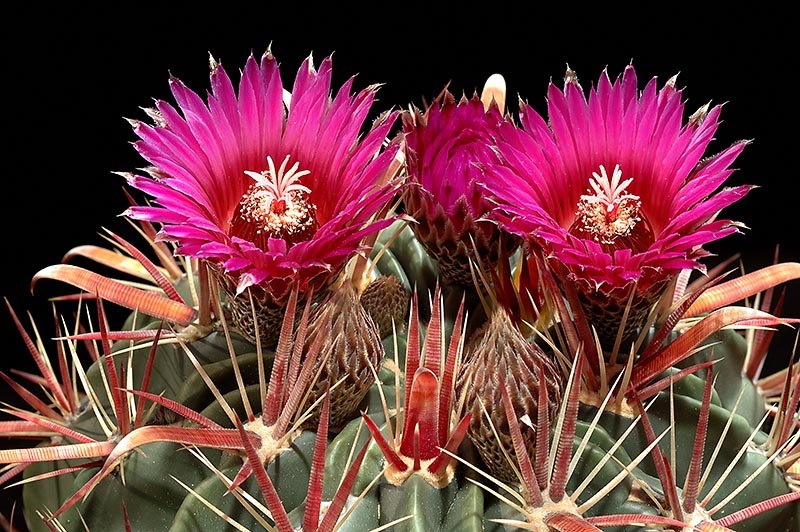Translate This Page
Ferocactus latispinus
Family: Cactaceae (Cactus Family)
Scientific name: Ferocactus latispinus (Haworth) Britton & Rose,
The Cactaceae; descriptions and illustrations of plants of the cactus family 3: 143-144, pl.
Etymology: The species name is derived from the Latin latus "broad", and spinus "spine".
Origin: The species is endemic to Mexico; the more widely distributed subspecies latispinus ranges from southeastern Durango, through Zacatecas, Aguascalientes, east to the western parts of San Luis Potosí, Hidalgo and Puebla, as well as to eastern Jalisco, Guanajuato, Querétaro and Mexico State. Subspecies spiralis is restricted to the southern parts of Oaxaca and Puebla.[1]
Conservation status: Listed in CITES appendix 2.

Photo and © copyright by Andrea B. (Bologna, Italy) http://www.cactusfriends.com/Andrea/index.html
Ferocactus latispinus from my collection
F. latispinus has bright purple flowers in winter, providing a welcome burst of color at a time of year when not many cacti are in bloom.
Description: F. latispinus is a modest-sized ball-shaped or flat-topped barrel cactus, which normally remains a solitary plant, without dividing or producing offsets. Ferocactus latispinus grows as a single globular light green cactus reaching the dimensions of
The 'latispinus' subspecies has 9-15 radial spines that range from thin & white to dark and stout, and is most prevalent.
The 'spiralis' subspecies has 5-7 stout radial spines.
Stem:. Flattened to spherical (in cultivation), diameter 25 to
Roots:
Ribs: 13 to 23 ribs, sharp
Spines:
Radial spines: 6-12 up to 2,5cm long, spreading out , smaller, translucent yellow to reddish straight that have almost no width at all.
Central spine(s):
Roots:
Flowers: Beautiful “glassy” rich-purple to straw-yellow, up to 6 cm long and 3cm broad. The funnel-shaped flowers are purplish or yellowish and reach
Bloom time:. Flowering is in late autumn or early winter, usually in October, but it usually flowers only if the weather is warm and sunny ( need a fair amount of bright sunlight to form) This species blooms very early, many young plants will bloom when they reach
Fruit:.oval-shaped scaled fruit which reach 2.5 cm (
Seeds:
Sun Exposure: Full sun
Recommended Temperature Zone: 9b-11
Frost Tolerance: Hardy to
Heat Tolerance:
Minimum Avg. Temperature:
Watering Needs: Little to moderate water when established
Cultivation: Slow growing to start but does well under cultivation. Use very draining soil, water during the aestival growth cycle (this plant need plenty of water) But needs to be avoided wetting the bodies of these plants while they are in sunlight. A wet cactus in the sun light can cause sun burning which can lead to scares or even fungal infections and death.
Needs full sun. Keep dry at
Propagation: Seeds are the only way of reproducing.
Notes: Originally described as Cactus latispinus in 1824 by English naturalist Adrian Hardy Haworth, it gained its current name in 1922 with the erection of the genus Ferocactus by American botanists Britton and Rose.
USE: The "Candy cactus" is used to make sweets. The middle is cored out and soaked in sugar, then chopped up and eaten.
Ferocactus latispinus Growing rare cacti from seeds.Beautiful cacti rare cacti exotic cactus forms. Rare Cactus description, special conditions to raise rare cacti from seeds